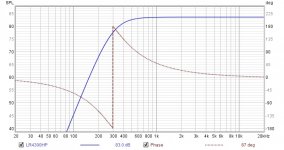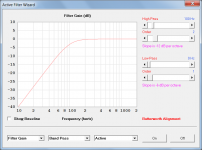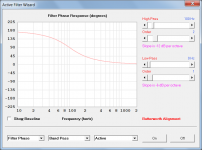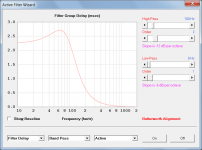I see your point, which is what I meant by "signal duration". These transients will dissipate very quickly. The turn-on step-function will indeed be broadband. I missed that.
I think we hear both. Frequency and amplitude, distortion, or modulation if Im allowed to use that term in this aspect.
Without getting too picky I can at least predict where and how much (estimation) start up transient distortion based off group delay without needing to point fingers at only one source (frequency or amplitude)
Leaving me with a theory that has application
Without getting too picky I can at least predict where and how much (estimation) start up transient distortion based off group delay without needing to point fingers at only one source (frequency or amplitude)
Leaving me with a theory that has application
Last edited:
We may well hear both, or we could be hearing just one or the other. There is no data on this, so your statement is a guess at best.
No one has gathered information regarding threshold of audibility for am and fm modulation?
I guess the threshold data encompassing group delay, can suffice as good enough?
I guess the threshold data encompassing group delay, can suffice as good enough?
Why do you want to look at radio wave modulation in the MHz range, when the discussion is about the audible range? Are you really planning to listen to AM radio on your high-end horn HiFi system?
🙂
🙂
I question'd if I could properly use the term modulation in this way. I use words like a person who reads the dictionary, not one who reads Jargon, forgive me.
Amplitude modulation detection with a short-duration carrier: Effects of a precursor and hearing loss
The role of cochlear place coding in the perception of frequency modulation | eLife
apparently it is actually a thing already
Amplitude modulation detection with a short-duration carrier: Effects of a precursor and hearing loss
The role of cochlear place coding in the perception of frequency modulation | eLife
apparently it is actually a thing already
Last edited:
Klipsch is a good place to start
http://www.readresearch.co.uk/loudspeaker_papers/klipsch_modulation_distortion_article_1.pdf
http://www.readresearch.co.uk/loudspeaker_papers/klipsch_modulation_distortion_article_1.pdf
No one has gathered information regarding threshold of audibility for am and fm modulation?
Not true at all. It depends on what you want to determine. There is the mathematical description as in THD and IMD, or ... a perceptual scale ... they are very different. But in either case these things have been studied in detail ... it's surprising that you are unaware of them. They are extremely important.
Camplo, there is a paragraph in the introduction to Newell and Holland's book Loudspeakers For Music Recording and Reproduction, Second Edition that seems very appropriate given the struggle with basic concepts. I'm sure Ro808 has provided a link somewhere to where it can be found.
"The object of this book is therefore to try to fill the gap which currently exists between the classic text books and the popular press. It will try to describe the theory behind, and the application of, the loudspeakers which are used for music recording and reproduction in a way that is accessible to those who would benefit from a greater understanding of the concepts, but who do not have anything more than a basic understanding of general science. Nevertheless, it is intended that the facts and descriptions will be both accurate and thorough, and where subjective aspects of loudspeaker performance are
discussed they will be backed up with objective and perceptual justification".
"The object of this book is therefore to try to fill the gap which currently exists between the classic text books and the popular press. It will try to describe the theory behind, and the application of, the loudspeakers which are used for music recording and reproduction in a way that is accessible to those who would benefit from a greater understanding of the concepts, but who do not have anything more than a basic understanding of general science. Nevertheless, it is intended that the facts and descriptions will be both accurate and thorough, and where subjective aspects of loudspeaker performance are
discussed they will be backed up with objective and perceptual justification".
I question'd if I could properly use the term modulation in this way. I use words like a person who reads the dictionary, not one who reads Jargon, forgive me.
I understood you from the beginning, or I think that I did.
Amplitude modulation is just another word for nonlinear. The amplitude of a higher tone is modulated by say a lower one. It's distortion.
Frequency modulation is interesting, but there aren't many processes in speakers that give rise to these kinds of nonlinearities. I did show many years back that FM modulation acts identical to AM for small nonlinearity, same sidebands different phases. I don't consider FM to be a comparable problem to AM in home speakers. It would take large excursions over a very wide bandwidth driver to make FM much of a contender for audio distortions.
Camplo, there is a paragraph in the introduction to Newell and Holland's book Loudspeakers For Music Recording and Reproduction, Second Edition that seems very appropriate given the struggle with basic concepts.
My book is free as a download on my sight, but it's not an introductory text.
😱 Group Delay, its the topic that just keeps giving 😀Amplitude modulation is just another word for nonlinear. The amplitude of a higher tone is modulated by say a lower one. It's distortion.
Indeed, I don't speak mathematics so much of it is in a foreign language to me. Still recommended for the parts that are in English 🙂My book is free as a download on my sight, but it's not an introductory text.
I tried imagining the concept of group delay/phase as pacman.
Pacman's mouth would be at 90 deg,
Or a quarter of one rotation after he started rolling 🙂
The time it took for him to roll the required distance from the start would be group delay. It is a function of how many times per second he makes a full rotation.
In visualizing how pacman translates to a sound wave, one member had an excellent avatar image of a rotating circle plotting a wave. Can't find the picture right now?
Would this be valid?
-waka waka
Pacman's mouth would be at 90 deg,
Or a quarter of one rotation after he started rolling 🙂
The time it took for him to roll the required distance from the start would be group delay. It is a function of how many times per second he makes a full rotation.
In visualizing how pacman translates to a sound wave, one member had an excellent avatar image of a rotating circle plotting a wave. Can't find the picture right now?
Would this be valid?
-waka waka
It's called complex exponentials - perfectly describes what you are talking about. They are the basis to the entire concept of Fourier Transform.
Thanks!
How is it that group delay seems to start low, peak, and come down again? Do computer simulations keep track of direction of spin, or can they be tricked? I've seen some moving pictures in which an object was spinning, but the direction of rotation seems to be differing between observers.
It felt like a glitch that group delay always seems to latch on to different directions of the spin in graphs, defaulting to the shortest rotation. Or is this observation not what happens in the math?
How is it that group delay seems to start low, peak, and come down again? Do computer simulations keep track of direction of spin, or can they be tricked? I've seen some moving pictures in which an object was spinning, but the direction of rotation seems to be differing between observers.
It felt like a glitch that group delay always seems to latch on to different directions of the spin in graphs, defaulting to the shortest rotation. Or is this observation not what happens in the math?
Group delay is calculated in programs like REW from the slope of the phase trace. If you look at the phase graph of any standard filter you can see where the shape comes from. The rate of phase change begins slowly then ramps up before settling down again, High to low in a High Pass filter.
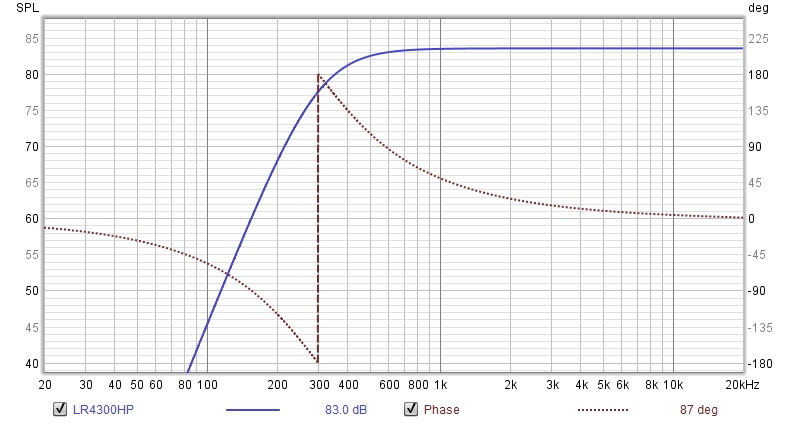
Attachments
Maybe it would be clearer to some readers if the phase on the diagram is displayed without the 360 degrees jump.
Just to add to the confusion: It is almost impossible to make steep crossovers with no group delay but it is possible to make such that have CONSTANT group delay (i.e no group delay distortion). A crossover with a constant group delay shows a phase response that is falling with frequency in a linear fashion. The final behaviour would be as if no group delay were present and the user pushed the start button a few hundred microseconds or a few miliseconds later.
Regards
Charles
Just to add to the confusion: It is almost impossible to make steep crossovers with no group delay but it is possible to make such that have CONSTANT group delay (i.e no group delay distortion). A crossover with a constant group delay shows a phase response that is falling with frequency in a linear fashion. The final behaviour would be as if no group delay were present and the user pushed the start button a few hundred microseconds or a few miliseconds later.
Regards
Charles
To add even more confusion, also note that the logarithmic frequency scale will make even a perfectly linear phase response(*) look bended 🙂
(*) which is simply a pure, frequency independent delay (i.e. a constant group delay)
(*) which is simply a pure, frequency independent delay (i.e. a constant group delay)
Last edited:
Maybe it would be clearer to some readers if the phase on the diagram is displayed without the 360 degrees jump.
The attachments show the gain, phase and group delay characteristics of a 100 Hz high-pass 2nd order Butterworth filter.
Group delay is the negative derivative in milliseconds of the phase response. It is a measure of the rate of change of phase with respect to frequency, and is positive when the phase slope is negative.
Attachments
- Home
- Loudspeakers
- Multi-Way
- Is it possible to cover the whole spectrum, high SPL, low distortion with a 2-way?
